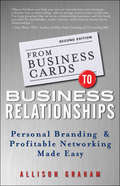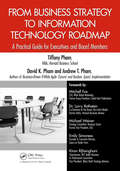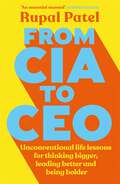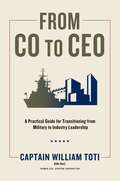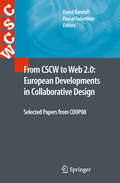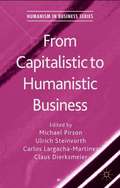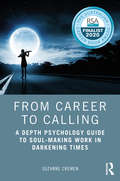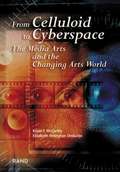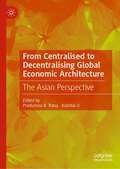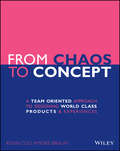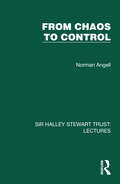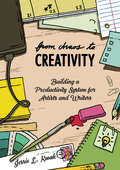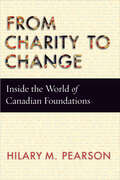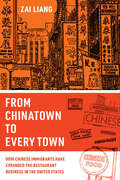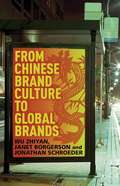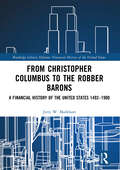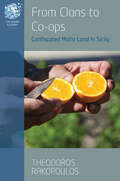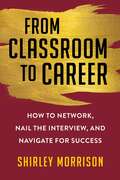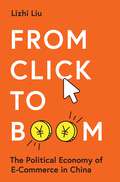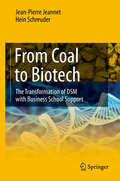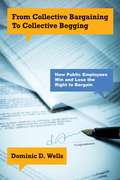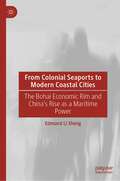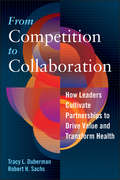- Table View
- List View
From Business Cards to Business Relationships
by Allison GrahamWant to supercharge your life? Effective networking is the answer and this book will teach you how.Professionals of all stripes and ages are told to 'get out there' and network so they can build their careers, grow their businesses and elevate their influence in the community, but they are rarely taught the skills to do that. Most people are lost, intimidated by the idea of presenting their own personal brand, and frustrated when it comes to networking. Despite long hours at events and attempts to make the right connections, they aren't seeing their desired results.From Business Cards to Business Relationships is a start-to-finish guide that demystifies the networking process and teaches readers how to truly benefit from getting connected. Allison Graham provides an easy to follow road map that is adaptable to your personality, circumstances and growth goals. You will learn how to strategically decide where to go, what to do when you get there and what to do afterwards to turn those casual business card contacts into meaningful relationships. Allison's approach is based on the Four Pillars of Profitable Networking: Perspective, Personal Brand, Procedures, and a Strategic Plan.This is a prescriptive, practical system based on the author's real-life experience of going from unconnected to connected in a short period of time. No cheesy gimmicks or high-pressure nonsense, just the skills and knowledge that will create success for anyone willing to do the work and follow this advice. Regardless of your past experience or current level of connectivity, your industry or profession, whether you're an entrepreneur or climbing the corporate ladder: you can accomplish whatever you want by meeting and connecting with the right people. From Business Cards to Business Relationships gives you the tools you need to cement a positive personal brand and build your own profitable network.Praise for From Business Cards to Business Relationships"Allison Graham can help you turn an introduction into a business, a dinner into a relationship, and an average practice into world class. I've long preached that we're in a relationship business, and this book provides the handshakes, codes, actions, and routes to master those relationships."--Alan Weiss, PhD, Author of Million Dollar Consulting and The Consulting Bible"At last--a networking book that actually makes sense! Allison Graham's four pillars of networking are as simple as they are powerful. If you are willing to follow her lead with consistent and persistent effort, you will make your mark and expand your horizons both personally and professionally."--Lou Heckler, Humorous Business Keynote Speaker and Speech Coach"This book is an excellent and much-needed resource to share with the business community."--PJ Hartson, Business Editor, Sun Media
From Business Strategy to Information Technology Roadmap: A Practical Guide for Executives and Board Members
by Tiffany Pham David K. Pham Andrew PhamWhether you are a CEO, CFO, board member, or an IT executive, From Business Strategy to Information Technology Roadmap: A Practical Guide for Executives and Board Members lays out a practical, how-to approach to identifying business strategies and creating value-driven technology roadmaps in your organization. Unlike many other books on the subject, you will not find theories or grandiose ideas here. This book uses numerous examples, illustrations, and case studies to show you how to solve the real-world problems that business executives and technology leaders face on a day-to-day basis.Filled with actionable advice you can use immediately, the authors introduce Agile and the Lean mindset in a manner that the people in your business and technology departments can easily understand. Ideal for executives in both the commercial and nonprofit sectors, it includes two case studies: one about a commercial family business that thrived to become a multi-million-dollar company and the other about a nonprofit association based in New York City that fights against child illiteracy.
From CIA to CEO: Unconventional life lessons for thinking bigger, leading better and being bolder
by Rupal PatelAn Analyst’s Guide for Entrepreneurship Development#1 New Release in EntrepreneurshipFormer CIA analyst Rupal Patel shares how you can dominate the entrepreneur industry using world-changing knowledge and skills.Combine state intelligence with corporate motivation. Starting her career in the Central Intelligence Agency, Rupal Patel soon found herself as an influential business advisor for leaders and CEOs around the world. Now, she shares how you can achieve your executive goals using clandestine advice. From CIA to CEO is a leadership book that uses esoteric strategies that will guide you to overcome challenges and achieve success, aimed not only at entrepreneurs and CEOs but also at professionals across all fields seeking to enhance their leadership and strategic thinking skills. Exploring the three biggest lessons that every successful entrepreneur must know, you can be bolder, think smarter, and lead better every step of the way to the top of your career.Unlock the CEO within. The road to success never starts with the business; it starts with their leaders, making this book a valuable resource for anyone looking to think bigger, lead better, and be bolder, regardless of their current role or industry. Based on her own journey from analyst to advisor, Rupal explores the best ways to amplify your strengths through expanding your skills. Dig deep into your identity and develop the trade that works for you. That way, your business can succeed in ways never thought possible.Inside From CIA to CEO, you’ll find tactical methods for the best entrepreneurship development possible, such as ways to:Create a long-term ops planInstall conviction into your company through mental frameworks How to take action when the mission goes wrongBecoming a mentor for future entrepreneursSo if you enjoyed entrepreneur books such as Million Dollar Weekend, Diary of a CEO, or BreakProof, then you will love From CIA to CEO.
From CO to CEO: A Practical Guide for Transitioning from Military to Industry Leadership
by Captain William J. TotiIn From CO to CEO: A Practical Guide for Transitioning from Military to Industry Leadership, William J. Toti, former CO of the nuclear submarine USS Indianapolis and former CEO of Sparton Corporation, offers a seminal manual for service members transitioning to civilian careers and navigating their rise up the corporate ladder. You&’ve served your country dutifully, and as a member of the US armed forces you&’ve also developed a discipline, drive, and skillset admired the world over. Your success in the civilian job market after your military career ends is all but ensured, right? Well, if statistics and real-life reports from your predecessors are any indication, this transition is not always smooth sailing. More than 200,000 service members separate from the military each year. More than half of those surveyed about the process felt as if they had little to no help with the transition. That&’s why William J. Toti, retired naval officer and CEO of Sparton Corporation, wrote From CO to CEO: A Practical Guide for Transitioning from Military to Industry Leadership. As someone who successfully progressed from captain of a nuclear submarine to a captain of industry, he knows what it takes to make the most of your military training and what more is needed to rise up the ranks in the C-suite. From CO to CEO aims to help you get the most out of your industry career, thinking through the kind of company and career track that is best for you. It provides a step-by-step guide to navigating the search, interview, and negotiation process and helps you acclimate to your new environment and to accelerate your climb to the top.
From CSCW to Web 2.0: European Developments in Collaborative Design
by David Randall Pascal SalembierMany challenges were identified in CSCW some thirty years ago, and some of these remain problematic today. However they are being progressively transformed and this edited volume contains contributions that demonstrate how these new challenges are being dealt with in a variety of ways, reflecting the balance of rigour and creativity that has always characterised the field. Originally presented at COOP '08 which took place in Carry-le-Rouet, France in 2008, the contributions to this volume have been substantially extended and revised. New technologies, new domains and new methods are described for supporting design and evaluation. Taking a progressive and critical stance, the authors cover a variety of themes including inter-organisational working, non task-based environments, creativity, and the development of Web 2.0 (and even Web 3.0) applications, including new cooperative mechanisms and new classification possibilities.
From Capitalistic to Humanistic Business
by Claus Dierksmeier Michael Pirson Ulrich Steinvorth Carlos Largacha-MartinezTransforming Capitalism addresses the challenges to shareholder capitalism. It explores: fair play in the market place;challenges on systemic, organizational and individual levels; the need to refocus our economic system around community and cooperation; the current challenges and transform capitalism.
From Career to Calling: A Depth Psychology Guide to Soul-Making Work in Darkening Times
by Suzanne CremenFinding and following an authentic calling challenges us to bridge both the intuitive, soulful and the hard-edged, material dimensions of everyday life. From Career to Calling: A Depth Psychology Guide to Soul-Making Work in Darkening Times opens new avenues for vocational exploration and career inquiry in an imaginative way. This unique book draws on insights from the field of Jungian and archetypal psychology to reimagine our attitudes and approaches to work, money, vocational guidance and career development. As people find themselves disillusioned with or disenfranchised from capitalist notions of work and career, Suzanne Cremen’s interdisciplinary approach illuminates how a creative, meaningful and influential work-life can emerge from attending to the archetypal basis of experience. Interweaving elements of her own journey, Cremen connects individual experience with the collective in an original way, spotlighting depression in the legal profession, marginalization of the feminine principle in work environments, and how understanding the roots of our cultural complexes can spark personal callings which facilitate collective transformation. Blending compelling real-life stories with robust scholarly analysis and reflective activities, this book will help practitioners to support individuals to develop a sense of their soul’s calling and offer guidance on creating an authentic vocational life within the constraints of the contemporary era. Additionally, it will be invaluable to those in career transition, re-discovering their purpose at the end of a career, or commencing work-life.
From Celluloid to Cyberspace
by Kevin F. Mccarthy Elizabeth Heneghan OndaatjeCurrent knowledge of the operation of the arts world and its underlying dynamics is limited, especially with regard to the media arts--art that is produced using or combining film, video, and computers. The authors examine the organizational features of the media arts, placing them in the context of the broader arts environment and identifying the major challenges they face. They take a structural point of view, discussing audiences, media artists as a group, arts organizations, and funding for the media arts.
From Centralised to Decentralising Global Economic Architecture: The Asian Perspective
by Pradumna B. Rana Xianbai JiThis book focuses on the recent rise of new regional economic institutions such as the Chiang Mai Initiative Multilateralisation, the Asian Infrastructure Investment Bank, and the Regional Comprehensive Economic Partnership, which were established, in part, as a result of dissatisfaction of dynamic emerging markets with global economic institutions such as the IMF, the World Bank, and the GATT/WTO. The latter were formed by advanced economies in the West, after the historic Bretton Wood Conference of 1944. In doing so, the book addresses how this recent round of decentralisation, defined as the co-existence of “senior” global institutions and a plethora of newly-established regional institutions, has affected global economic governance, and the delivery of global public goods. It also poses the question if this has led to the fragmentation of global economic governance. The book adds value to existing literature by using a benefit-risk analytical framework to study the decentralisation process. Unlike the “contested multilateralism” argument used by some authors which focuses on the costs of decentralisation, the authors argue that benefits must also be considered. It also describes and analyses the establishment of global and regional international economic institutions and the evolving relationships between the two. Third, the authors argue that this decentralisation process will continue in the postpandemic period and recommend policies to reset the relationship between global and regional institutions. And lastly, the book discusses proposals to reform the international monetary system including the global reserve system with a view to reducing the hegemony of the US dollar.Throughout the book, the role for Asia is also identified, and elaborated on.
From Chaos to Concept: A Team Oriented Approach to Designing World Class Products and Experiences
by Kevin Collamore BraunThis book is written for product design, software development, graphic design, and UX professionals with a focus on creating measurably better user experiences. If you want to design solutions to meet business goals and delight your users, you can look to this resource which covers the following areas: Creating and documenting goals, strategies, objectives, and tactics Defining or refining personas based on your measurable objectives (OKRs) Creating and iterating on scenarios based your prioritized personas A team approach to defining the product and roadmap to address critical use cases Team based divergent ideation and solution exploration Team based convergent solution definition Wireframing potential solutions for rapid research and iteration Using quantitative and qualitative methods to understand usage and test with users Exploring approaches to taxonomy and information architecture Using psychology and human factors to drive your design decisions Developing performant, accessible, maintainable experiences Using analytics to measure the results and inform the next iteration How this process differs based on the size of the company or team that is employing it
From Chaos to Control (Sir Halley Stewart Trust: Lectures)
by Norman AngellOriginally published in 1933, this volume From Chaos to Control represents the expansion of notes used in the delivery of the Halley Stewart Lectures for 1932–1933. Following on from the economic lecture of the previous year, this title covers “the psychology of popular understanding, of the nature of the public mind in relation to the technical problems discussed by last year’s lecturers; a problem of education, of politics.”This book is a re-issue originally published in 1933. The language used and views portrayed are a reflection of its era and no offence is meant by the Publishers to any reader by this re-publication.
From Chaos to Creativity: Building a Productivity System for Artists and Writers
by Jessie L. KwakArt and writing can be the most fulfilling part of our lives. But it's often difficult to make space for it in our day-to-day existence, especially if we're not at the point yet where creating it is our job. Sometimes we have so many ideas it&’s difficult to keep them all organized, much less maintaining a creative schedule or dedicated workspace. With all the clutter overwhelming your scattered brain (not to mention your desk), it's all too easy to fall into procrastination and disarray. From Chaos to Creativity is a series of glowing beacon. Jessie L. Kwak has written a Getting Things Done for artists and writers, drawing on her experience as a professional copywriter with a novel-writing habit, and from interviews with other authors, artists, musicians, and designers, to teach you how to focus on the good ideas, manage your project, make time in your life, and execute your passions to completion. Make great art by channeling your chaotic creative force into productive power and let the world see what you're capable of!
From Charity to Change: Inside the World of Canadian Foundations
by Hilary M. PearsonThe world of philanthropy and private foundations remains mysterious to most Canadians. Memorably likened to giraffes, foundations are creatures that should not exist, but they do, surrounded by a certain mystique.In From Charity to Change Hilary Pearson demystifies the world of Canadian philanthropy, offering a portrait of today’s foundation landscape and highlighting organizations that are acting with purpose on some of the most pressing social and economic challenges of our time: climate change, the future of cities, education and the evolving workforce, housing, and the urgent need to repair and build new relationships with Indigenous Peoples. Pearson, who for two decades worked with leaders of foundations across Canada, provides an insider’s perspective on the ways these organizations continue to evolve. Through personal interviews with private funders – large and small, long established and newly formed – Pearson describes their strategies and the varied roles they play, whether as convenors, advocates, brokers, or partners.A timely contribution to the current debate on the legitimacy of organized philanthropy in an era of increasing social division and inequality, From Charity to Change makes a compelling case for the valuable role private philanthropy plays in addressing the challenges of our rapidly changing times.
From Charity to Justice: How NGOs Can Revolutionise Our Response to Extreme Poverty
by Vincent FangThis book focuses on the ethical demands of extreme poverty and develops a political theory of practical change. Welding together political realism and moral aspirations, it argues that a re-imagined form of development NGO can help the global North break free from the dominant and persistent charity paradigm and drift towards a justice-based understanding of extreme poverty. It offers an original explanation of why the charity paradigm persists and why the “justice not charity” messages from development NGOs have changed few minds. The author argues that anyone concerned with a paradigm shift from charity to justice need to radically rethink the problem of political communication: who should communicate what messages about extreme poverty in what ways? Based on a rational choice critique of the competitive development NGO sector, the author calls for sector-wide reform and the emergence of a new political agent – the Avant-garde NGO - which transcends the charity frame that NGOs currently find themselves locked in. Further, inspired by literary theory and social psychology, he offers a fresh account of how the Avant-garde NGO could, through reflective public engagement, induce attitude change and lead genuine social and political reform.
From Chinatown to Every Town: How Chinese Immigrants Have Expanded the Restaurant Business in the United States
by Zai LiangFrom Chinatown to Every Town explores the recent history of Chinese immigration within the United States and the fundamental changes in spatial settlement that have relocated many low-skilled Chinese immigrants from New York City's Chinatown to new immigrant destinations. Using a mixed-method approach over a decade in Chinatown and six destination states, sociologist Zai Liang specifically examines how the expansion and growing popularity of Chinese restaurants has shifted settlement to more rural and faraway areas. Liang's study demonstrates that key players such as employment agencies, Chinatown buses, and restaurant supply shops facilitate the spatial dispersion of immigrants while simultaneously maintaining vital links between Chinatown in Manhattan and new immigrant destinations.
From Chinese Brand Culture to Global Brands
by Wu Zhiyan Janet Borgerson Jonathan SchroederFrom Chinese Brand Culture to Global Brands examines branding from the Chinese perspective, and predicts that China's greatest brands are poised for global dominance.
From Christopher Columbus to the Robber Barons: A Financial History of the United States 1492–1900 (Financial History of the United States)
by Jerry W. MarkhamOriginally published in 2002, this is the first of three volumes in a history of finance in America. This volume covers the period from the 'discovery' of America to the end of the nineteenth century. It describes the status of finance in Europe at the time of Christopher Columbus' voyage to America. It then traces its transfer and development in America through the Revolution, into the Civil War and beyond to the speculative excesses occurring after that event.
From Clans to Co-ops: Confiscated Mafia Land in Sicily (The Human Economy #4)
by Theodoros RakopoulosFrom Clans to Co-ops explores the social, political, and economic relations that enable the constitution of cooperatives operating on land confiscated from mafiosi in Sicily, a project that the state hails as arguably the greatest symbolic victory over the mafia in Italian history. Rakopoulos’s ethnographic focus is on access to resources, divisions of labor, ideologies of community and food, and the material changes that cooperatives bring to people’s lives in terms of kinship, work and land management. The book contributes to broader debates about cooperativism, how labor might be salvaged from market fundamentalism, and to emergent discourses about the ‘human’ economy.
From Classroom to Career: How to Network, Nail the Interview, and Navigate for Success
by Shirley MorrisonAn authentic, engaging, and practical guide to help college grads thrive personally and professionally.The rules have changed; the traditional workplace is dead. To BOOM in employment today, the secret is to alter the approach, and From Classroom to Career will tell you how. Gen Z and Millennials are asking for this value-led guide as they embark on careers.Entertaining, personal, and relatable, the voice of the book is purposely casual, as if speaking in a café. It&’s a voice everyone trusts. Reasonable, logical, and concrete advice for today&’s how-to: how to write a business email; how to successfully land and then stand out in an interview, including in a virtual world; how to ask questions that can be adapted to any job/role; how to write a CV with examples. Inspiring, surprising, real-life stories show empathy for what the readers are likely going through, so they&’ll forget it&’s a business book.From Classroom to Career integrates the personal and career. This is in fact the real reality of every human being: we&’re so much more than careerists. It&’s impossible to thrive career-wise if you are not happy outside of work. People are happier when they have a balance, enabling them to achieve personally and professionally. By helping readers to discover their own values, this guide gets them to think about their own career and who they want to be. This is entirely unlike any other business book out there.
From Click to Boom: The Political Economy of E-Commerce in China (Princeton Studies in Contemporary China)
by Lizhi LiuHow the world&’s largest e-commerce market highlights a digital path to developmentHow do states build vital institutions for market development? Too often, governments confront technical or political barriers to providing the rule of law, contract enforcement, and loan access. In From Click to Boom, Lizhi Liu examines a digital solution: governments strategically outsourcing tasks of institutional development and enforcement to digital platforms—a process she calls &“institutional outsourcing.&”China&’s e-commerce boom showcases this digital path to development. In merely two decades, China built from scratch a two-trillion-dollar e-commerce market, with 800 million users, seventy million jobs, and nearly fifty percent of global online retail sales. Contrary to conventional wisdom, Liu argues, this market boom occurred because of weak government institutions, not despite them. Gaps in government institutions compelled e-commerce platforms to build powerful private institutions for contract enforcement, fraud detection, and dispute resolution. For a surprisingly long period, the authoritarian government acquiesced, endorsed, and even partnered with this private institutional building despite its disruptive nature. Drawing on a plethora of interviews, original surveys, proprietary data, and a field experiment, Liu shows that the resulting e-commerce boom had far-reaching effects on China.Institutional outsourcing nonetheless harbors its own challenges. With inadequate regulation, platforms may abuse market power, while excessive regulation stifles institutional innovation. China&’s regulatory oscillations toward platforms—from laissez-faire to crackdown and back to support—underscore the struggle to strike the right balance.
From Coal to Biotech
by Jean-Pierre Jeannet Hein SchreuderThis management book documents the remarkable transformation of DSM, first from a coal mining company to a commodity chemicals producer and then in the last two decades to the life sciences & materials sciences company it is today, with its strong focus on biotechnology. The book gives an inside view on the 'strategic learning cycles' that have driven this evolutionary transformation. It also discusses the company traits that have contributed to its ability to adapt, grow and prosper. Renowned business schools such as IMD and Babson have accompanied the second transformation of DSM through their executive education programs. The book documents this support and draws lessons for long-term collaboration between companies and the business school world.
From Collective Bargaining to Collective Begging: How Public Employees Win and Lose the Right to Bargain
by Dominic D. WellsHow do public employees win and lose their collective bargaining rights? And how can public sector labor unions protect those rights? These are the questions answered in From Collective Bargaining to Collective Begging. Dominic Wells takes a mixed-methods approach and uses more than five decades of state-level data to analyze the expansion and restriction of rights. Wells identifies the factors that led states to expand collective bargaining rights to public employees, and the conditions under which public employee labor unions can defend against unfavorable state legislation. He presents case studies and coalition strategies from Ohio and Wisconsin to demonstrate how labor unions failed to protect their rights in one state and succeeded in another. From Collective Bargaining to Collective Begging also provides a comprehensive quantitative analysis of the economic, political, and cultural factors that both led states to adopt policies that reduced the obstacles to unionization and also led other states to adopt policies that increased the difficulty to form and maintain a labor union. In his conclusion, Wells suggests the path forward for public sector labor unions and what policies need to be implemented to improve employee labor relations.
From Colonial Seaports to Modern Coastal Cities: The Bohai Economic Rim and China’s Rise as a Maritime Power
by Edmund Li ShengThis book explores China's ambition to build itself into a maritime power. Despite having a continental coastline of 18,000 kilometers and territorial waters that cover an area one-third the size of its land mass, China has traditionally been considered a continental power. However, Beijing is currently trying to change this historical situation through two national strategies. This book will use the world-island and sea-power theories to explore the development of China’s maritime power from historical and geopolitical perspectives. Using fieldwork, in-depth interviews, and comprehensive data collection, this book will present a series of compelling examples and vivid stories to help readers understand China’s maritime strategies, with interest for China scholars, historians and economists alike.
From Competition to Collaboration: How Leaders Cultivate Partnerships to Drive Value and Transform Health (ACHE Management)
by Tracy DubermanEvery healthcare executive knows that the US health system is in desperate need of repair, yet the path to real change remains unclear. The shift to value-based care is a step in the right direction, but the move to control costs while enhancing quality will require a significant transformation in all sectors of the field. No single enterprise can address these challenges on its own—organizations must work together, and across sectors, to optimize the value of their services and address affordability, access, and cost. From Competition to Collaboration: How Leaders Cultivate Partnerships to Drive Value and Transform Health explains how healthcare leaders can navigate the difficult issues that arise when multiple organizations from different sectors and with different operating models, objectives, and cultures work together toward a shared purpose. By using this book's health ecosystem leadership model (HELM), leaders can shift their mind-set toward a broader purpose, focusing not just on healthcare but on health and promoting wellness. Authors Tracy Duberman and Robert Sachs provide a roadmap for developing new leadership competencies. Using HELM, innovative leaders can work across the various segments of healthcare to meet the mission of creating healthier communities. To illustrate how this model is best applied, the authors offer a detailed fictional case study, as well as real-life examples from leaders who have demonstrated success with collaborative ecosystem initiatives. The book helps define the skills required for ecosystem leadership and presents concrete, actionable techniques and strategies for development. To make the essential shift toward healthier communities, healthcare needs leaders capable of building and maintaining relationships across the health ecosystem. From Competition to Collaboration offers the tools and guidance to help drive leaders toward this shared purpose.What Readers Are SayingKudos to Tracy Duberman and Bob Sachs for developing such an insightful and productive approach to help leaders succeed in their everyday efforts and defining moments by enhancing collaboration across the health industry. For any executive coach looking to support and inspire clients to reach up, out, and across, this is the essential playbook.”—Marshall Goldsmith, Multimillion-selling author or editor of 39 books, including Triggers and What Got You Here Won’t Get You There“If nothing else, my 25 years in healthcare as a frontline provider, physician leader, health plan executive, and health system executive have convinced me that meaningful transformation of the United States healthcare system is a team sport. The ecosystem is simply too vast and complex to allow for significant success in silos. This timely book is both informative and optimistic. It not only details the leadership traits required to drive meaningful change—more important, it lays out inspiring examples of where this is happening today, what can be learned, and, most critically, what can be cultivated.”—David G. Carmouche, MD, President, Ochsner Health Network, Senior Vice President of Community Care, Ochsner Health System
From Competitive Advantage to Corporate Strategy
by Michael E. PorterA study of the diversification records of 33 large U.S. companies from 1950 to 1986 shows that diversification--whether through acquisition, joint venture, or start-up--generally has not brought the competitive advantages or profitability expected. Portfolio management, restructuring, transferring skills, and sharing activities are four concepts of corporate strategy that companies most commonly use. Portfolio management no longer works very well in the United States because of its highly developed capital market. Restructuring is merely a stopgap measure that will not build shareholder value over the long term because it usually produces an unwieldy conglomerate. Companies have the best chance of being successful at diversification if they capitalize on the existing relationships between business units by having them transfer skills and share activities. McKinsey Award Winner.
